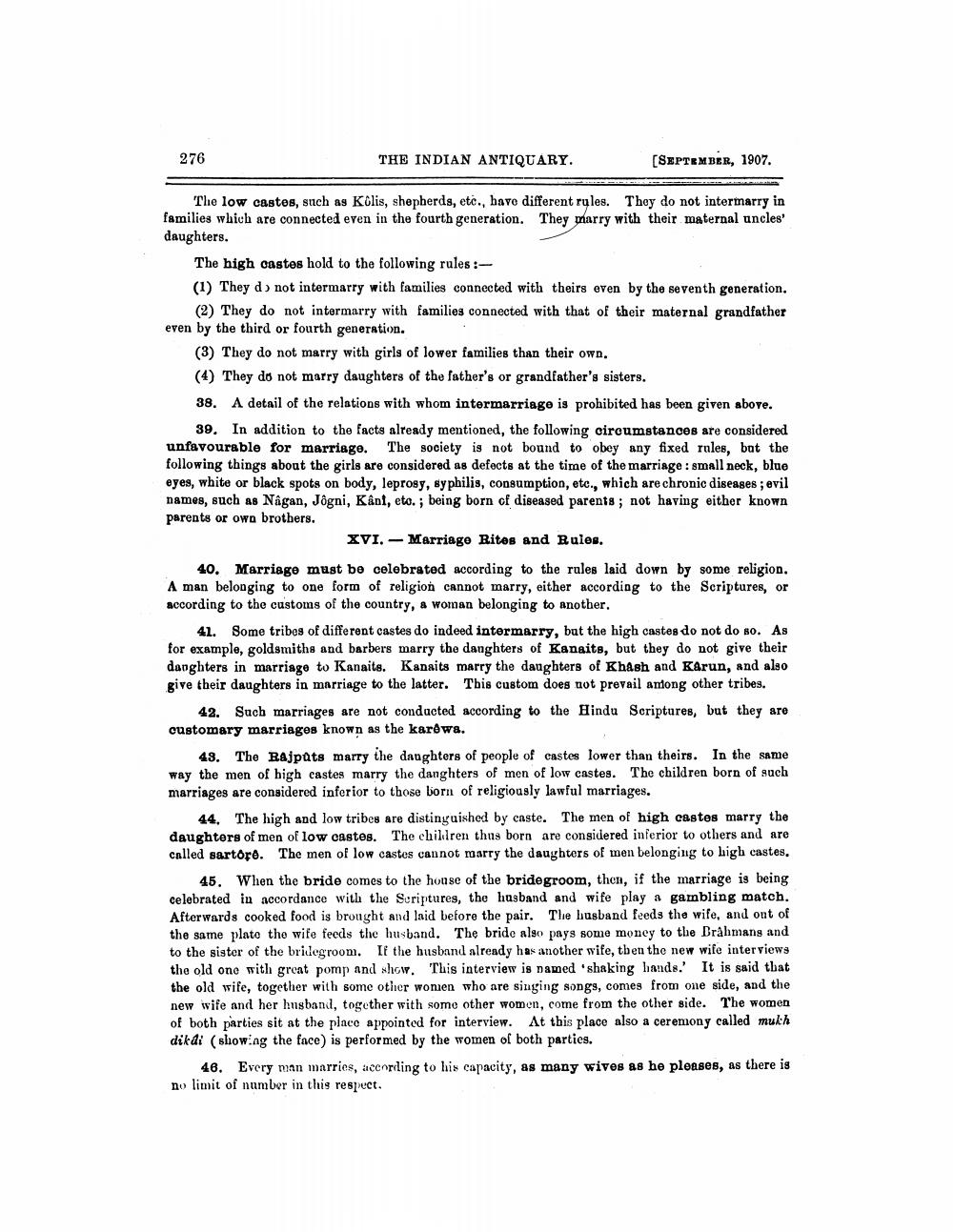________________
276
THE INDIAN ANTIQUARY.
[SEPTEMBER, 1907.
The low castes, such as KClis, shepherds, etc., have different rules. They do not intermarry in families which are connected even in the fourth generation. They marry with their maternal uncles' daughters.
The high castes hold to the following rules :(1) They do not intermarry with families connected with theirs even by the seventh generation.
(2) They do not intermarry with families connected with that of their maternal grandfather even by the third or fourth generation.
(3) They do not marry with girls of lower families than their own. (4) They do not marry daughters of the father's or grandfather's sisters. 38. A detail of the relations with whom intermarriage is prohibited has been given above.
39. In addition to the facts already mentioned, the following circumstances are considered unfavourable for marriage. The society is not bound to obey any fixed rules, but the following things about the girls are considered as defects at the time of the marriage : small neck, blue eyes, white or black spots on body, leprosy, syphilis, consumption, etc., which are chronic diseases; evil names, such as Nagan, Jögni, Kânt, eto. ; being born of diseased parents ; not having either known parents or own brothers.
XVI. - Marriage Rites and Rules. 40. Marriage must be celebrated according to the rules laid down by some religion, A man belonging to one form of religion cannot marry, either according to the Scriptures, or according to the customs of the country, a woman belonging to another,
41. Some tribes of different castes do indeed intermarry, but the high castes do not do so. As for example, goldsmiths and barbers marry the daughters of Kanaits, but they do not give their danghters in marriage to Kanaits. Kanaits marry the daughters of Khash and Karun, and also give their daughters in marriage to the latter. This custom does not prevail among other tribes.
42. Such marriages are not conducted according to the Hindu Scriptures, but they are customary marriages known as the kardwa.
43. The Rajpats marry the daughters of people of castes lower than theirs. In the same way the men of high castes marry the danghters of men of low castes. The children born of such marriages are considered inferior to those born of religiously lawful marriages.
44. The high and low tribes are distinguished by caste. The men of high castes marry the daughters of men of low castes. The chillren thus born are considered inferior to others and are called sartore. The men of low castes cannot marry the daughters of men belonging to high castes.
45. When the bride comes to the house of the bridegroom, then, if the marriage is being celebrated in accordance with the Scriptures, the husband and wife play & gambling match. Afterwards cooked food is brought and laid before the pair. The husband feeds the wife, and ont of the same plato the wife feeds the husband. The bride also pays some money to the Brahmang and to the sister of the bridegroom. If the husband already has another wife, then the new wife interviews the old one with great pomp and show. This interview is named 'shaking hands. It is said that the old wife, together with some other women who are singing songs, comes from one side, and the new wife and her husband, together with some other women, come from the other side. The women of both parties sit at the place appointed for interview. At this place also a ceremony called mukh dikdi (slowing the face) is performed by the women of both parties.
46. Every man marries, according to his capacity, as many wives as he pleases, as there is no limit of number in this respect.




